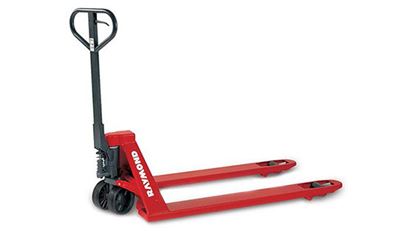Pallet Jacks | Riverside

Raymond West is a Riverside supplier of new and used electric and manual pallet jacks.
We are backed by one of the largest service and parts operations in Southern California.
Call us today at (951) 384-2444
If you are looking at the purchase of pallet trucks, it's valuable to examine the advantages and some of the disadvantages of assorted styles of pallet jacks.
Naturally, the foremost function of a pallet jack is to position pallets around a warehouse, loading dock or other business where pallets will need to be transferred.
That being said, in consideration of the capacity of your facility, the weight of pallets being positioned, the consistency of utilization, and other variables, you will most likely want to get a better knowledge of which pallet jacks perform best in which environments.
The following write-up is a synopsis of pallet jack options, capabilities, limitations and types of applications.
Hand Pallet Jacks
Manual pallet trucks have been used since the early 1900's and have not changed much since then. They are composed of a steel chassis, a fork and a hydraulic unit that's mobilized by pumping the handle vertically.
The operator of a manual pallet truck places the forks beneath the pallet, boosts the pallet away from the ground and wheels the pallet to a secondary location, driving the pallet jack with the "tiller" or handle.
Situations where lift height is not required may be a suitable use for a manual pallet jack, including retail aisles, warehouse back rooms and related uses. As opposed to a forklift, manual pallet trucks are also relatively mobile and will fit in the back of a truck or van for delivering products. The load capability of the majority of manual pallet jacks is around 5500 lbs.
Hand pallet jacks are ideal for infrequent use situations over limited distances. They are not the most effective choice for moving loads across lengthier ranges, steep gradients or rough surfaces. Operators need to physically push or pull the equipment which may be physically draining after a period of time.
Walkie Pallet Jacks
Although about two times the overall size of non-powered pallet jacks, walkies are still relatively small in size and they're highly maneuverable.
Walkie pallet jacks are powered by on-board battery packs. The battery delivers an electrical assist for driving and elevating the forks. The operator no longer has to pump the tiller to lift the payload, nor do they have to manually maneuver the pallet across the warehouse.
However, they are still called "walkies", given that the driver does still have to walk in back of or next to them.
A walkie pallet truck's peak speed is low when compared with rider jacks, because the user has to keep up with the jack rather than catching a ride on it. This is effectively a bit of a built in "safety feature", since restricted speeds also minimize the impact of collisions.
The weight capacity of most walkie pallet jacks is between 4500-6000 lbs.
Although they're more user-friendly than manual pallet jacks, walkies must be charged consistently, because they're battery based. They also necessitate more service than hand pallet jacks given that there are far more moving components and points of possible electrical problems.
The key uses for walkie pallet jacks are trailers, dock plates and short to middle distance runs.
Rider Pallet Jacks
Rider pallet trucks are like walkies, except that they feature a basic riding platform for the operator. There are minimal controls on rider pallet trucks so they're quite uncomplicated to control and need minimal training.
Controllers can climb aboard the platform as opposed to just walking beside or behind the jack. This means that rider trucks are a much better choice for moving payloads over lengthier distances vs hand or walkie pallet trucks. They're most suitable for regular movement over greater distances and they are used frequently in large warehouse complexes and industrial enterprises.
The operator platform is suited for shorter spans, but not ideal for operators that work with them day in and day out because they're relatively small and cause the operator to stand at a sideways angle.
Rider jacks are much heavier than walkie or hand pallet jacks, so accidents can trigger relatively severe trauma and property damage. Rider pallet trucks provide very little defense for the driver vs other alternatives like center riders.
Center Riders
Center riders are reminiscent of rider pallet jacks, but they are safer for the driver and furnish a more ergonomic experience. The user can stand entirely to the front or to the back as opposed to just to the side.
There is also reduced hazard for the operator considering they're insulated by the equipment body on two sides, although they're still vulnerable to the somewhat unlikely danger of the lifting system.
Center riders are harder to turn than rider pallet jacks and they are best suited for uses where the controller drives predominantly in a straight path.
Center riders are frequently employed in general factory operations, warehouse and beverage uses.
Where To Rent Or Buy Pallet Trucks In Riverside, California
If you’d like to talk to a representative about pallet jacks, please get in touch with Raymond West, a Riverside material handling equipment supplier serving South San Bernardino and Riverside County, including: Riverside, Redlands, Colton, Rialto, Bloomington, Moreno Valley, Hemet, Perris, Lake Elsinore, Menifee and the Coachella Valley.
Riverside, CA
6185 Magnolia Ave
Riverside, CA 92506
(951) 384-2444
7:00 AM - 5:00 PM
Monday - Friday

